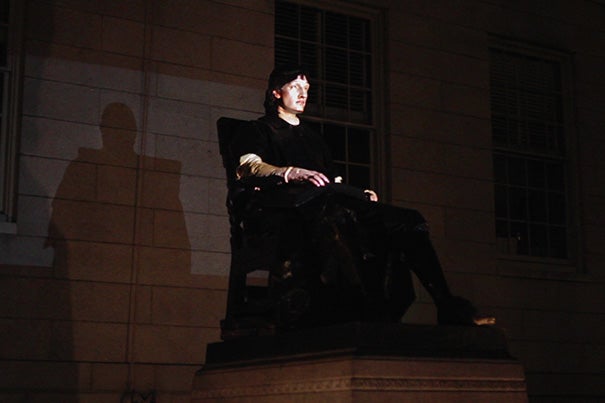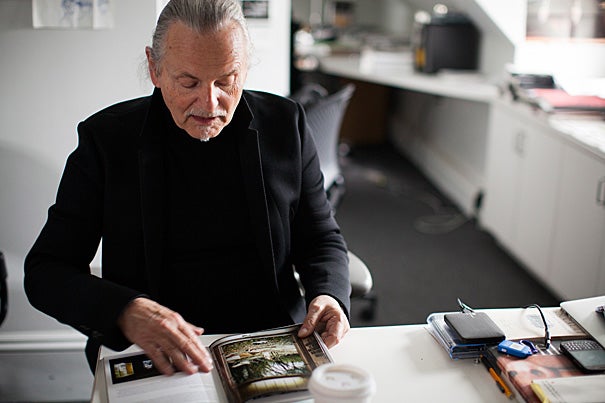
“John Harvard Projection” will animate the John Harvard Statue with the voices, gestures and images of Harvard students.
Photos by Robert Eckel
John Harvard ‘speaks’
As part of public art project, students help to animate Harvard’s iconic campus statue
This week, the John Harvard Statue comes alive.
Don’t be alarmed if you amble past the famed bronze sculpture after dark and it speaks to you. It’s supposed to.
For the next week, Daniel Chester French’s iconic work will be animated by the faces, voices, and gestures of Harvard students as part of “John Harvard Projection,” a video installation created by artist and Harvard Graduate School of Design (GSD) Professor Krzysztof Wodiczko.
“The sculpture is already a student,” said Wodiczko, who added that projecting images of current students onto the statue will entertain, create conversation, and refresh the statue as a work of art of many voices. “In this way,” he said, “the statue can be a kind of vehicle for creating some sort of community.”
Born in Poland during the 1943 Warsaw ghetto uprising, Wodiczko uses large-scale projections on monuments and public facades to engage challenging social issues and often a lend voice to those who are unable or reluctant to speak. His 2012 animation of the Abraham Lincoln statue in New York City’s Union Square offered veterans and their families the chance to discuss the trauma of war. In 1998, he illuminated Boston’s Bunker Hill Monument with the images and voices of mothers whose children had been murdered. Other projects have involved immigrants and homeless men and women.
At Harvard, the artist wanted to offer students from across the University — some of whom might want their voices to be heard more — the chance to express themselves. He encouraged them to discuss their undergraduate or graduate experiences. Many also chose to speak about their lives before Cambridge, or their post-graduation plans, hopes, and dreams.

Their years at Harvard represent “the present time in which the past and the future dwell,” said Wodiczko, “from which one becomes a new person.”
Tiffany Agard ’15 welcomed the chance to briefly become part of one of the world’s most-photographed statues.
“You representing John Harvard, and John Harvard representing you is a very powerful statement for owning your place on this campus and for really affirming your spot and your presence here,” she said. “I think it also provides an incredible platform for discussion.”
To create the work, Wodiczko and his team, including GSD students and members of the Boston-based design firm Materials & Methods, first captured the students on film and took a 3-D scan of the statue. Using special software, they transformed the videos into a type of pixilated “mesh” image that can wrap around the sculpture’s face and hands. The final result brings the statue to life with the voices and faces from Harvard’s student body.
The Harvard University Committee on the Arts commissioned Wodiczko to create a high-profile public art installation this spring as part of its ongoing commitment to incorporating art more fully into University life. It’s a project with students at its core. Wodiczko began discussing the idea last fall in his seminar “Art, Design, and the Public Domain,” recalled GSD student Scott Valentine, who worked closely with the artist on the installation.
“We were seeing how we could intervene with the statue on some level, because it does have this prescribed and cultural history here on campus. But we really wanted to think about how we could update it,” said Valentine. “What better way to reanimate the statue than with the current student body?”
Students first met with the artist, who discussed his previous projection works and the idea behind the John Harvard piece. But he offered little in the way of direction. Instead, Wodiczko encouraged the students to “think about what it is that ought to be said in public that is not discussed enough in public.”
Next, the students signed up to be videotaped discussing their thoughts. Hope, anxiety, a desire to be successful, the urge to make a difference, and the importance of connecting with others emerged as recurring themes from the roughly 30 interviews.
Senior Aticus Peterson spoke about the “amazing people” he regularly meets at Harvard. He also expressed his frustration with those who don’t acknowledge their own vulnerabilities or weaknesses.
“One of the things we are really good at is putting on a face,” he said, “and acting like we’re doing well, acting like we’re successful.” Peterson said some of his most valuable Harvard connections have come “when both people are wiling to admit things they are struggling with or to admit that vulnerability.”
Gerald Jean-Baptiste, a student in the arts in education program at the Harvard Graduate School of Education (HGSE) and the son of Haitian immigrants, discussed feeling isolated on campus because of a lack “of people who look like me.”
“If I am John Harvard in the statue, if I am knowledge, if I am representing knowledge,” he said, “there is none of me here.”
Sophomore Kristen Shim, whose grandparents immigrated to the United States in the 1970s from South Korea, talked about how being at Harvard meant being part of the American dream. She also described the challenge of really getting to know people, and her decision to reach out to others who might feel the same.
The approximately half-hour videotaped sessions required precise preparations. Volunteers wore black shirts and sat with their hands and heads arranged in the same position as the seated John Harvard, to ensure that their images would map perfectly to his. Their heads were kept in place with a small brace; they could gesture, but they had to return their hands to the same position after each motion.
During the sessions, Wodiczko would occasionally prompt the students, asking them to expand on something they had said, but they were free to respond however they pleased.
The artist called the projection “an interruption and provocation and inspiration. … Not too harsh, not too tough, maybe a little comical, maybe a little entertaining, but still thought-provoking.”
Speaking of Harvard’s motto, the Latin word for truth, he said, “What is veritas? What veritas? Whose veritas?” Wodiczko hopes that the installation will create conversation, and that people “might talk about this behind the scenes.”
Peterson said he thinks the project can help contribute to a dialogue about the Harvard student experience.
“Harvard as a whole is made up of lots of individual people with lots of individual experiences who struggle with different things and who are good at different things,” said Peterson. “What I like about this project is that it breaks it down and lets you have a kind of bottom-up view.”
The “John Harvard Projection” will be on view April 20-27. It will be visible after dark.




